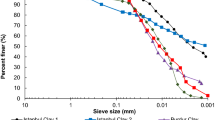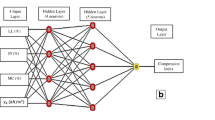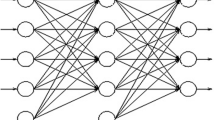Abstract
Adaptive neuro-fuzzy inference system (ANFIS) and artificial neural network (ANN) models have been extensively used to predict different soil properties in geotechnical applications. In this study, it was aimed to develop ANFIS and ANN models to predict the unconfined compressive strength (UCS) of compacted soils. For this purpose, 84 soil samples with different grain-size distribution compacted at optimum water content were subjected to the unconfined compressive tests to determine their UCS values. Many of the test results (for 64 samples) were used to train the ANFIS and the ANN models, and the rest of the experimental results (for 20 samples) were used to predict the UCS of compacted samples. To train these models, the clay content, fine silt content, coarse silt content, fine sand content, middle sand content, coarse sand content, and gravel content of the total soil mass were used as input data for these models. The UCS values of compacted soils were output data in these models. The ANFIS model results were compared with those of the ANN model and it was seen that the ANFIS model results were very encouraging. Consequently, the results of this study have important findings indicating reliable and simple prediction tools for the UCS of compacted soils.











Similar content being viewed by others
References
Akbulut S (2005) Artifical Neural Networks for predicting the hydraulic conductivity of granular soils. J Eurasian Sci 4:446–452
Akbulut S, Kalkan E, Celik S (2003) Artificial Neural Networks to estimate the shear strength of compacted soil samples. Int Conf New Dev Soil Mech Geotech Eng 1:285–290
Akbulut S, Hasiloglu AS, Pamukcu S (2004) Data generation for shear modulus and damping ratio in reinforced sands using adaptive neuro-fuzzy inference system. Soil Dyn Earthq Eng 24:805–814
Ali H, Najjar YM (1999) Neuronet-based approach for assessing the liquefaction potential of soils. Transportation Research Record, No: 1633, 3–8
Buckley JJ, Hayashi Y (1994) Fuzzy neural networks. In: Zadeh LA, Yager RR (eds) Fuzzy sets, neural networks and soft computing. Van Nostrand Reinhold, New York, pp 233–249
Cal V (1995) Soil classification by neural-network. Adv Eng Softw 22(2):95–97
Celik S (2004) Modeling of stress and deformation properties in soils with Artificial Neural Networks. Dissertation, Ataturk University, Erzurum
Chen KZ, Leung Y, Leung KS, Gao X (2002) A neural network for solving nonlinear programming problems. Neural Comput Appl 11(2):103–111
Donald AW (1986) A guide to expert systems. Addison-Wesley, Reading
Erzin Y, Erol O (2007) Swell pressure prediction by suction methods. Eng Geol 92:133–145
Fausett L (1994) Fundamentals of neural networks: architectures, algorithms, and applications. Prentice Hall, Englewood Cliffs
Flood I, Nabil K (1994) Neural networks in Civil Engineering II: systems and applications. J Comput Civil Eng 8(2):149–162
Georgiadis K, Potts DM, Zdravkovic L (2004) Modeling the shear strength of soils in the general stress space. Comput Geotech 31:357–364
Goksan TS, Uzundurukan S, Keskin SN, Yildirim H (2004) Usability of Artificial Neural Networks in the determination of suction capacity. 10th National Congress of Soil Mechanics and Foundation Engineering, Istanbul, Turkey
Hagan MT, Demuth HB, Beale M (1995) Neural network design. PWS Publishing Company, Boston
Hagan MT, Demuth HB, Beale M (1999) Neural network design. PWS Press
Hamed MM, Khalafallah MG, Hassanien EA (2004) Prediction of wastewater treatment plant performance using artificial neural networks. Environ Model Softw 19:919–928
Jang JRS (1991) Fuzzy modeling using generalized neural networks and Kalman filter algorithm. Proc. Ninth. Natl. Conf. Artif. Intell. (AAAI-91), 762–767
Jang JRS (1993) ANFIS: adaptive-network-based fuzzy inference systems. IEEE Trans Syst Man Cybern 23(03):665–685
Jang JSR, Sun CT, Mizutani E (1997) Neuro-fuzzy and soft computing: a computational approach to learning and machine intelligence. Prentice-Hall International, London
Johnson RB, DeGraff JV (1988) Principles of engineering geology. John Wiley and Sons, Inc., USA
Kalkan E, Bayraktutan MS (2008) Geotechnical evaluation of Turkish clay deposits: a case study in Northern Turkey. Env Geol 55:937–950
Kandel A (1988) Fuzzy expert systems. Addison-Wesley, Reading
Kandel A (1992) Fuzzy expert systems. CRC Press, Boca Raton
Kaya MD, Hasiloglu AS, Bayramoglu M, Yesilyurt H, Ozok AF (2003) A new approach to estimate anthropometric measurements by adaptive neuro-fuzzy inference system. Int J Ind Ergon 32:105–114
Kerh T, Hu YG, Wu CH (2003) Estimation of consolidation settlement caused by groundwater drawdown using artificial neural networks. Adv Eng Softw 34:559–568
Khalili N, Khabbaz MH (1998) A unique relationship for the determination of the shear strength of unsaturated soils. Geotechnique 48(5):681–687
Lee IM, Lee JH (1996) Prediction of pile bearing capacity using artificial neural networks. Comput Geotech 18(3):189–200
Lee SJ, Lee SR, Kim YS (2003) An approach to estimate unsaturated shear strength using artificial neural network and hyperbolic formulation. Comput Geotech 30:489–503
Levine ER, Kimes DS, Sigillito VG (1996) Classification soil structure using neural networks. Ecological Modelling 92:101–108
Liebowitz J (1990) The dynamics of decision support system and expert system. The Dryden Press, Orlando
Liebowitz J, Desalvo DA (1989) Structuring expert systems: domain, design, and development. Prentice-Hall, Englewood Cliffs, NJ
Liu Q, Button E, Klima K (2007) Investigation for probabilistic prediction of shear strength properties of clay-rich fault gouge in the Austrian Alps. Eng Geol 94:103–124
Najjar YM, Basheer IA, Naous WA (1996) On the identification of compaction characteristics by neuronets. Comput Geotech 18(3):167–187
Pedrycz W (1989) Fuzzy control and fuzzy systems. Wiley, New York
Penumadu D, Zhao R (1999) Triaxial compression behavior of sand and gravel using artificial neural networks (ANN). Comput Geotech 24:207–230
Rahman MS, Wang J, Deng V, Carter JP (2001) A neural network model for the uplift capacity of suction caissos. Comput Geotech 28:269–287
Rassam DW, Williams DJ (1999) A relationship describing the shear strength of unsaturated soils. Can Geotech J 36:363–368
Rumelhart DE, Hinton GE, William DE (1986) Learning internal representations by error propagation. In: Rumelhart DE, McClelland JL (eds) Parallel distributed processing: explorations in the microstructure of cognition. The MIT Press, Vols. 1–8, 318–362
Sahin MA, Jaksa MB, Maier HR (2001) Artificial neural network applications in geotechnical engineering. Aust Geomech 36:49–62
Sahin MA, Maier HR, Jaksa MB (2002) Predicting settlement of shallow foundations using neural networks. ASCE Geotech Geoenviron Eng 128(9):785–793
Sinha SK, Wang MC (2008) Artificial neural network prediction models for soil compaction and permeability. Geotech Geol Eng 26:47–64
Sivrikaya O, Togrol E, Komur M (2004) Determination of unconfined compressive strength by Artificial Neural Network. 10th National Congress of Soil Mechanics and Foundation Engineering, Istanbul, Turkey
Sozen A, Arcaklioglu E, Ozalp M (2004) Estimation of solar potential in Turkey by artificial neural networks using meteorological and geographical data. Energy Convers Manage 45:3033–3052
Sugeno M (1985) Industrial applications of fuzzy control. Elsevier, Amsterdam
Sugeno M, Kang GT (1988) Structure identification of fuzzy model. Fuzzy Sets Syst 28:15–33
Takagi T, Sugeno M (1985) Fuzzy identification of systems and its applications to modeling and control. IEEE Trans Syst Man Cybern 15:116–132
Tortum A (2003) The Modeling of Mode Choices of Intercity Freight Transportation with The Artificial Neural Networks And Integrated Neuro-Fuzzy System, Dissertation, Ataturk University, Erzurum
Tsoukalas LH, Uhrig RE (1997) Fuzzy and neural approaches in engineering. Wiley, NY
Vanapalli SK, Fredlund DG, Pufahl DE, Clifton AW (1996) Model for the prediction of shear strength with respect to soil suction. Can Geotech J 33:379–392
Vincent CY (1999) Rule selection in fuzzy expert systems. Expert Syst Appl 16:79–84
Werbos P (1974) Beyond regression: new tools for prediction and analysis in the behavioral sciences. Dissertation, Harvard University
Zorlu K, Gokceoglu C, Ocakoglu F, Nefeslioglu HA, Acikalin S (2008) Prediction of uniaxial compressive strength of sandstones using petrography-based models. Eng Geol 96:141–158
Acknowledgments
The laboratory study of this research was carried out in the Soil Mechanics Laboratory of Civil Engineering Department, Engineering Faculty of Ataturk University. So, the authors thank the authorities of the Civil Engineering Department.
Author information
Authors and Affiliations
Corresponding author
Rights and permissions
About this article
Cite this article
Kalkan, E., Akbulut, S., Tortum, A. et al. Prediction of the unconfined compressive strength of compacted granular soils by using inference systems. Environ Geol 58, 1429–1440 (2009). https://doi.org/10.1007/s00254-008-1645-x
Received:
Accepted:
Published:
Issue Date:
DOI: https://doi.org/10.1007/s00254-008-1645-x




